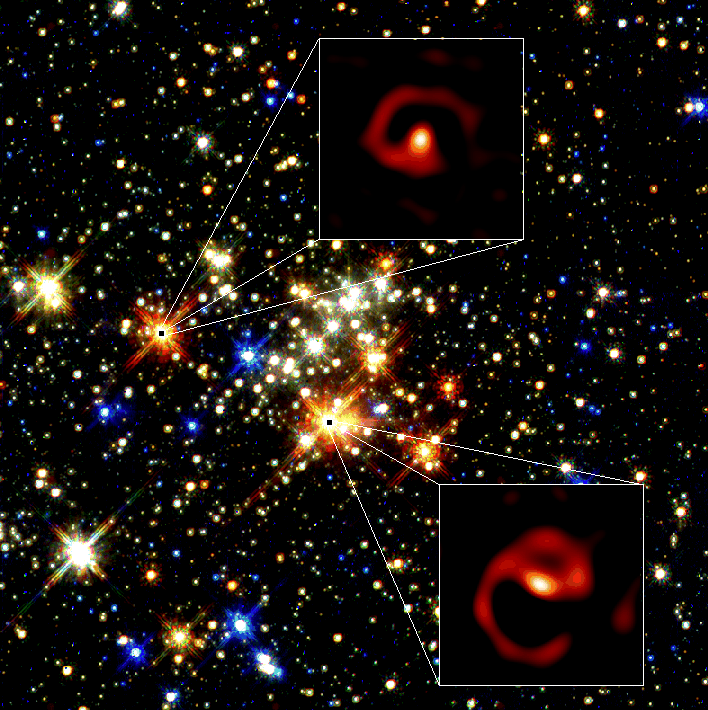The Quintuplet: A Yin and Yang in the Galactic Center |
|---|

The Quintuplet: A Yin and Yang in the Galactic Center |
|---|

In a discovery hailed by Astronomers and New-Agers alike, a great cosmic Yin and Yang, many times the size of our entire solar system, has been found right near the center of our Galaxy. The myriad stars in the background are from a Hubble Space Telescope image of the Quintuplet Cluster, one of the most massive young open star clusters known. The Quintuplet is right next door (within 100 light-years) to the center of our Galaxy, and was christened after the five bright red stars visible in the image. The true nature of these five have been something of an astronomical enigma: could they be young stars with dusty disks, or old stars with dust shells?
Using advanced imaging techniques on the world's biggest telescope, the 10m Keck in Hawaii, we have been able to zoom up on two of the five Quintuplet stars with a magnification five times greater than Hubble can attain. Our new images are shown inset, with lines to indicate the true scale compared to the Hubble picture. With the extra resolution, the dust plumes surrounding the stars can be seen to follow the beautiful elegant spiral form, now familiar to us as typical of a Wolf-Rayet colliding-wind binary like WR 104 or WR 98A.
We learn a lot by studying these spiral plumes. At the heart of each lies a colliding-wind binary star (see WR 104 for an explanation of the spiral), and the geometry of the plume allows us to measure the properties of the binary including the orbital period, inclination to the line of sight, and the distance. Within the astronomy world, there has been a surge of interest in these stars. Wolf-Rayets are very massive stars at the very end-point of their normal lives: they are the last stable phase before a supernova explosion. Massive binary systems such as these pinwheel stars will, in fact, explode three times: two explosions as each of the pair separately undergoes a core-collapse supernova, then a third explosion as the two fall into each other in an inspiral/merger event (possibly in the quite-distant future). Each of these supernovae types is now believed to be also linked to a corresponding gamma-ray burst - highly energetic phenomena which can be seen at very great distances in the universe.
When one of the central stars explodes as a supernova, the expanding blast wave will pass through the region of space near to the star, sweeping up and interacting with the spiral plumes. Recent careful observations of the lightcurves of supernovae show indications of small wiggles in intensity, which are believed to be due to the spiral coils of the pinwheel plume being consumed by the explosion fireball.
This research appears in:
For an
ABSTRACT of the paper, click here (link to SCIENCE)
For
FULL TEXT of the paper, click here (link to SCIENCE)
Photo Credit: Sydney University Physics Department/W.M. Keck Observatory
The Research Team:
Peter Tuthill is a reasearcher in the
School of Physics at the University of Sydney, Australia.
John Monnier works at U.Michigan
Angelle Tanner is at the
Jet Propulsion Lab in California
Don Figer works at Rochester Institute of Technology
Andrea Ghez works at UCLA
William Danchi is at the
NASA Goddard Space Flight Center in Greenbelt, Maryland.
For more information, contact: